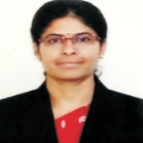
Mamatha Gowda
Work place: Electrical and Electronics Engineering, SJB Institute of Technology, No.67, BGS Health & Education City, Bengaluru, Karnataka
E-mail: mahesh.mamatha@gmail.com
Website:
Research Interests:
Biography
Dr. Mamatha M. Gowda has received Bachelor Degree from Mangalore University, Masters from Bangalore and Doctorate from Prairie View A & M University, Texas, USA in the field of Electrical Engineering. She has 17 years of Teaching Experience and 5 years of industrial experience. Currently she is working as a Professor in the Department of EEE at SJB institute of Technology, Bengaluru, Karnataka, India. Her area of research interest are Power Electronics, Motor Drives and Controls, Renewable Energy, Power Systems and Control Systems.
Author Articles
Power System Stability Improvement by LQR Approach and PSS Considering Electric Vehicle as Disturbance
By Niharika Agrawal Mamatha Gowda
DOI: https://doi.org/10.5815/ijisa.2022.03.03, Pub. Date: 8 Jun. 2022
Low frequency oscillations result due to heavy loading conditions line faults, sudden change of generator output and also due to poor damping of interconnected power systems. There are different types of disturbances in the power system like sudden change of load, generation, faults, switching of lines. This hampers the power transmission capacity of the lines and the stability of the system There are significant impacts on the system stability during the charging and discharging operation of Electric Vehicle (EV). In the present work the charging operation of EV is considered as a load disturbance. The introduction of these vehicles in the system creates the problem of low frequency oscillation and endanger the system stability and security. In the present work the Single machine infinite bus system (SMIB) is first developed using mathematical modelling with consideration of EV disturbance. The LQR approach from optimal control theory is then applied in the system to damp the system oscillations, improving the system eigenvalues and enhancing the stability. The stability is seen in the system after LQR from various figures. In the second work the plotting of variation of different state variables is done using three different methods which are the transfer function model method, using code and then using state space representation of the system. The work is further extended by adding Power system stabilizer (PSS) to the system, again considering the EV disturbance. The time domain simulation results showed the improvement in stability using PSS device. Thus, in the present work the oscillations problems created due to the introduction of electric vehicles are solved by two methods. The first is implementing LQR approach from optimal control theory in the system and the second method is by adding PSS device in the same system.
[...] Read more.Other Articles
Subscribe to receive issue release notifications and newsletters from MECS Press journals